-
(单词翻译:双击或拖选)
I’m Bob Doughty1.
VOICE TWO:
And I’m Steve Ember with EXPLORATIONS in VOA Special English. This week we look at an industry that is facing major changes -- the automobile3 industry.
(MUSIC)
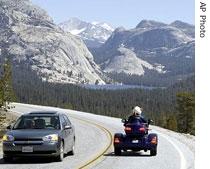 |
| On the road, near Yosemite, California |
Americans, possibly more than any other people, love their cars. Ownership of cars is a sign of middle class wealth. A car has long been part of the American dream. For many people, nothing provides a feeling of freedom like driving in a powerful car on the open road. But high fuel prices and changes in technology are causing people to change the way they look at the car.
(MUSIC)
VOICE ONE:
The car industry is changing more quickly than almost any other industry. Just ask General Motors. This year the American company celebrates one hundred years of being in business. GM remains4 the biggest car company in the world for now. But Toyota of Japan is positioning itself to become the world leader very soon. General Motors has been losing market share to foreign carmakers at home for years. For two thousand seven, General Motors lost almost thirty-nine billion dollars. That is believed to be the largest one-year loss in the history of the auto2 industry.
General Motors finds itself in a changing marketplace. During the nineteen nineties, much of GM's profits came from the sale of large sports utility vehicles, or SUVs. However, rising gas prices have made these big, fuel-hungry vehicles unpopular. And GM has struggled to offer new vehicles that use less fuel.
VOICE TWO:
However, GM has made its own changes. In January, Mark LaNeve, GM's North American vice6 president of sales and marketing7, spoke8 at the Washington, D.C. Auto Show. He discussed ways that GM was changing itself into a car company for the twenty-first century. He said that GM is looking forward to competing in the next one hundred years. Mister LaNeve noted9 that not only was it important for GM to compete in the United States but also around the world.
The fastest growth markets are not in industrial nations any longer but in the developing world. And in these areas, GM is doing increasingly well. Mister LaNeve said that GM had increased sales in three of four areas around the world. The North American market was the only one in which sales did not grow.
(MUSIC)
VOICE ONE:
The market for cars around the world is changing in ways that are more complex than simply the size or style of cars. One of the most interesting new developments comes from India's biggest company, the Tata Group, which owns Tata Motors. Tata Motors recently bought the high-cost car models Jaguar10 and Land Rover from American carmaker Ford11 in a deal worth two-point-three billion dollars.
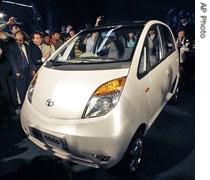 |
| Tata Motors' Nano |
But in January, Tata Motors made big news by announcing that it would start selling a very small car that costs only two thousand five hundred dollars.
The car, called the Nano, is designed mainly for India's home market, but its price has caught the attention of the world. The Nano is the result of a different kind of engineering. Instead of designing things to add to the vehicle, engineers thought of ways to remove things. For example, the car has very little storage space. Parts like the steering12 column, which helps the car to turn, are made of less costly13, lighter14 materials. As with any lightweight car, safety is a major issue. The car could be very dangerous if it is in an accident. But the Nano does have four doors and five seats. And its price puts it within the reach of millions of people in India.
VOICE TWO:
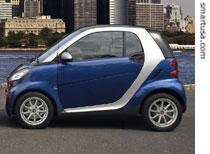 |
| The 2008 Smart Fortwo |
Tata Motors' Nano is mainly meant for the Indian market. But the German company Daimler makes a very small car meant for markets in industrial countries. It is called the Smart Fortwo. Almost eight hundred thousand of an early version of the car have been sold in thirty-six countries. Now Daimler will try to sell the Smart Fortwo in the American car market.
The car is less than three meters long and less than two meters wide. Still it has many of the things that people in industrial countries expect from a car. For example, the car can have a radio, air-cooling and many other details. However, its cost is not as low as you might think. The least costly version of the Smart Fortwo is over eleven thousand dollars.
VOICE ONE:
Smaller cars are just one direction that the car industry is taking. The industry is also producing cars that limit pollution and have a less harmful effect on the environment. Many experimental versions of cars are being made using new technologies. These include cars that run on fuels like ethanol, hybrid15 cars that use both fuel and electric power and fully16 electric cars. Added to these are fuel cell vehicles.
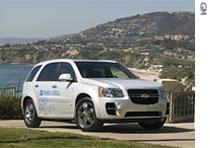 |
| GM's Chevy Equinox Fuel Cell |
At the Washington Auto show, a GM product called the Chevrolet Equinox Fuel Cell won top honors as an environmentally friendly vehicle. This fuel cell car won the Green Car Journal's Green Car vision award. The Equinox Fuel Cell is powered by an engine that uses hydrogen to produce electricity.
But recently, both GM and Toyota have questioned whether fuel cell cars can be offered at a price most people can afford. GM Vice Chairman Bob Lutz spoke at the auto show in Geneva, Switzerland last month. He said there has been recent progress in power-storing lithium-ion batteries. He said future electric cars may be able to travel nearly five hundred kilometers before the batteries need to be recharged.
Toyota is working on fuel cell cars too. However, the company's president, Katsuaki Watanabe, confirmed that fuel cells are just too costly to be available in the next ten years. Toyota is the leading maker5 of hybrid vehicles. These run on both electrical power and gas.
(MUSIC)
VOICE TWO:
The automobile industry is changing in ways that would seem surprising to people only a few years ago. Toyota, for example, is expected to become the largest car company in the world very soon. But while Toyota has gained market share in North America and other Asian countries, the company is facing falling sales at home.
In Japan, new car sales fell to a thirty-five year low in two thousand seven. Sales for new cars, trucks and buses fell over seven percent. High fuel costs and good public transportation are two reasons driving has become less popular in Japan.
An opinion study by a Japanese newspaper found that only twenty-five percent of Japanese men in their twenties wanted a car at all. That was down from forty-eight percent in two thousand. The study was reported by the Wall Street Journal.
VOICE ONE:
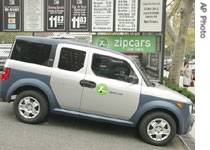 |
| A Zipcar in New York City |
Another trend involves not owning but sharing a car. Zipcar is a company based in Cambridge, Massachusetts. It is the world's largest car-sharing business. Members pay each time they use a Zipcar. The car is left in a place were it is available to other members.
The company is growing quickly. Zipcar recently joined with a similar company, Flexcar. The merger17 is expected to be complete soon. The combined company will have one hundred eighty thousand members and five thousand vehicles. Zipcar does business in the United States, Canada and Britain.
And Zipcar is not the only company interested in car- sharing. Reports say vehicle rental18 businesses are interested in competing with Zipcar. In early February, Enterprise19 Rent-A-Car entered the car-sharing business in Saint20 Louis, Missouri. Its program is called WeCar. Other companies such as U-Haul International have similar car-sharing businesses and the car rental company Hertz is considering one.
Enterprise, which is the biggest car rental company by sales, says it is seeking a different business model from Zipcar. It wants to provide shared cars to businesses.
VOICE TWO:
Shared cars are seen as an environmentally friendly way to use cars without owning one. Car- sharing reduces the number of cars on the road. Many of the cars are models that burn less fuel and produce less pollution. For example, Enterprise provides the Toyota Prius hybrid car for its members.
Car-sharing could be one way that people use cars in the future. Smaller cars and electric models are also a growing part of the future of cars. But as tens of millions of new cars are sold each year, one thing is clear: cars are still as popular as ever.
(MUSIC)
VOICE ONE:
This program was written and produced by Mario Ritter. I’m Bob Doughty.
VOICE TWO:
And I’m Steve Ember. For transcripts21, MP3s, podcasts and Special English on TV, go to voaspecialenglish.com. Join us again next week for Explorations in VOA Special English.
 收听单词发音
收听单词发音
1
doughty

|
|
| adj.勇猛的,坚强的 | |
参考例句: |
|
|
|
2
auto

|
|
| n.(=automobile)(口语)汽车 | |
参考例句: |
|
|
|
3
automobile

|
|
| n.汽车,机动车 | |
参考例句: |
|
|
|
4
remains

|
|
| n.剩余物,残留物;遗体,遗迹 | |
参考例句: |
|
|
|
5
maker

|
|
| n.制造者,制造商 | |
参考例句: |
|
|
|
6
vice

|
|
| n.坏事;恶习;[pl.]台钳,老虎钳;adj.副的 | |
参考例句: |
|
|
|
7
marketing

|
|
| n.行销,在市场的买卖,买东西 | |
参考例句: |
|
|
|
8
spoke

|
|
| n.(车轮的)辐条;轮辐;破坏某人的计划;阻挠某人的行动 v.讲,谈(speak的过去式);说;演说;从某种观点来说 | |
参考例句: |
|
|
|
9
noted

|
|
| adj.著名的,知名的 | |
参考例句: |
|
|
|
10
jaguar

|
|
| n.美洲虎 | |
参考例句: |
|
|
|
11
Ford

|
|
| n.浅滩,水浅可涉处;v.涉水,涉过 | |
参考例句: |
|
|
|
12
steering

|
|
| n.操舵装置 | |
参考例句: |
|
|
|
13
costly

|
|
| adj.昂贵的,价值高的,豪华的 | |
参考例句: |
|
|
|
14
lighter

|
|
| n.打火机,点火器;驳船;v.用驳船运送;light的比较级 | |
参考例句: |
|
|
|
15
hybrid

|
|
| n.(动,植)杂种,混合物 | |
参考例句: |
|
|
|
16
fully

|
|
| adv.完全地,全部地,彻底地;充分地 | |
参考例句: |
|
|
|
17
merger

|
|
| n.企业合并,并吞 | |
参考例句: |
|
|
|
18
rental

|
|
| n.租赁,出租,出租业 | |
参考例句: |
|
|
|
19
enterprise

|
|
| n.企业单位,商业公司,事业,计划 | |
参考例句: |
|
|
|
20
saint

|
|
| n.圣徒;基督教徒;vt.成为圣徒,把...视为圣徒 | |
参考例句: |
|
|
|
21
transcripts

|
|
| n.抄本( transcript的名词复数 );转写本;文字本;副本 | |
参考例句: |
|
|
|















